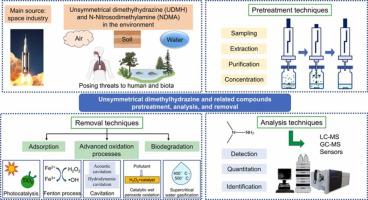Journal of Hazardous Materials ( IF 12.2 ) Pub Date : 2022-03-20 , DOI: 10.1016/j.jhazmat.2022.128708 Cong Hu 1 , Yuan Zhang 2 , Yu Zhou 3 , Zhi-Fei Liu 2 , Xue-Song Feng 2

|
Unsymmetrical dimethylhydrazine (1,1-Dimethylhydrazine, UDMH) has been widely used as aerospace fuel in many countries. The launch of space vehicles can cause the release and leakage of UDMH into the environment, posing serious threats to ecology system and human population. Even worse, the health risks are also pertinent to its numerous classes of transformation products including N-Nitrosodimethylamine (NDMA), because most of them display carcinogenic and mutagenic properties. Recently, there has been an intense ongoing development of simple, fast, green, and effective techniques for determining and removing these hazardous substances. This review summarizes the latest research progress regarding the sources, fates, pretreatment, analysis, and removal techniques of UDMH and related products in the environment. Sample preparation methods mainly include pressurized liquid extraction, liquid-phase microextraction techniques, solid-phase extraction, headspace-solid-phase microextraction, and supercritical fluid extraction. Detection and identification methods mainly include high-performance liquid chromatography coupled with tandem mass spectrometry (HPLC-MS/MS), gas chromatography coupled with tandem mass spectrometry (GC-MS/MS), and sensors. Removal methods mainly include advanced oxidation processes, adsorption, biodegradation techniques. The advantages/disadvantages, applications, and trends of the proposed approaches are thoroughly discussed to provide a valuable reference for further studies.
中文翻译:

环境中的不对称二甲肼及相关化合物:预处理、分析和去除技术的最新进展
不对称二甲基肼(1,1-二甲基肼,UDMH)已在许多国家广泛用作航空航天燃料。航天器的发射会导致UDMH释放和泄漏到环境中,对生态系统和人口构成严重威胁。更糟糕的是,健康风险也与其众多类别的转化产品有关,包括 N-亚硝基二甲胺 (NDMA),因为它们中的大多数都具有致癌和致突变特性。最近,用于确定和去除这些有害物质的简单、快速、绿色和有效的技术正在蓬勃发展。本综述总结了环境中UDMH及相关产物的来源、归宿、预处理、分析和去除技术的最新研究进展。样品制备方法主要包括加压液体萃取、液相微萃取技术、固相萃取、顶空固相微萃取和超临界流体萃取。检测鉴定方法主要有高效液相色谱-串联质谱联用(HPLC-MS/MS)、气相色谱-串联质谱联用(GC-MS/MS)、传感器等。去除方法主要包括高级氧化工艺、吸附、生物降解技术。对所提出方法的优缺点、应用和趋势进行了深入讨论,为进一步研究提供有价值的参考。和超临界流体萃取。检测鉴定方法主要有高效液相色谱-串联质谱联用(HPLC-MS/MS)、气相色谱-串联质谱联用(GC-MS/MS)、传感器等。去除方法主要包括高级氧化工艺、吸附、生物降解技术。对所提出方法的优缺点、应用和趋势进行了深入讨论,为进一步研究提供有价值的参考。和超临界流体萃取。检测鉴定方法主要有高效液相色谱-串联质谱联用(HPLC-MS/MS)、气相色谱-串联质谱联用(GC-MS/MS)、传感器等。去除方法主要包括高级氧化工艺、吸附、生物降解技术。对所提出方法的优缺点、应用和趋势进行了深入讨论,为进一步研究提供有价值的参考。


















































 京公网安备 11010802027423号
京公网安备 11010802027423号